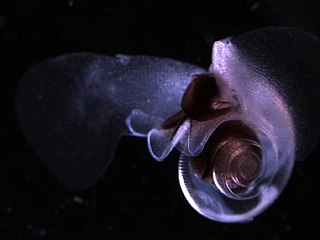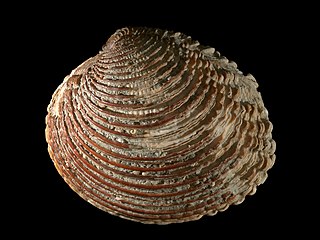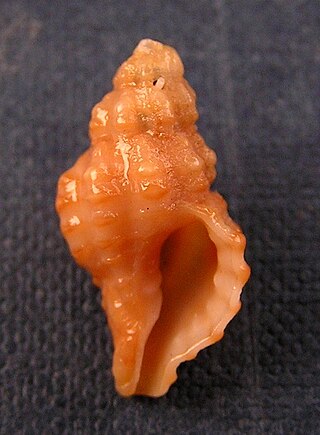
The Thecosomata, or sea butterflies, are a taxonomic suborder of small, pelagic, free-swimming sea snails known as holoplanktonic opisthobranch gastropod mollusks, in the order Pteropoda. Most pteropods have some form of calcified shell, although it is often very light, even translucent.
Desmopteridae is a family of pelagic sea snails or "sea butterflies", marine gastropod mollusks in the superfamily Cymbulioidea.

The Veneridae or venerids, common name: Venus clams, are a very large family of minute to large, saltwater clams, marine bivalve molluscs. Over 500 living species of venerid bivalves are known, most of which are edible, and many of which are exploited as food sources.

The Trochidae, common name top-snails or top-shells, are a family of various sized sea snails, marine gastropod molluscs in the subclass Vetigastropoda. This family is commonly known as the top-snails because in many species the shell resembles a toy spinning top.

Atlantidae is a family of sea snails, holoplanktonic gastropod molluscs in the clade Littorinimorpha.

Carinaria is a genus of medium-sized floating sea snails, pelagic gastropod molluscs in the family Carinariidae.
Cardiapoda is a genus of very small floating sea snails or heteropods, pelagic gastropod molluscs or micromolluscs in the family Carinariidae.

Pterotracheidae is a family of medium-sized to large floating sea snails, pelagic gastropod molluscs. They are in the superfamily Pterotracheoidea along with two other similar pelagic families, the Atlantidae and the Carinariidae.

The Bursidae, common name "frog snails" or "frog shells", are a small taxonomic family of large sea snails, marine gastropod predatory snails in the clade Littorinimorpha.

Pseudococculinidae is a family of small sea snails or false limpets, marine gastropod mollusks in the superfamily Lepetelloidea.

Vasinae, common name the vase snails or vase shells, are a taxonomic subfamily of large predatory sea snails, marine gastropod mollusks within the family Turbinellidae.

The Pterotracheoidea is, according to the Taxonomy of the Gastropoda, a taxonomic superfamily of sea snails or sea slugs, marine gastropod molluscs in the clade Littorinimorpha. They are commonly called heteropods or sea elephants.

Argyropeza is a genus of small deep-sea sea snails in the family Cerithiidae.

The Drilliidae are a taxonomic family of small predatory sea snails with high-spired shells. They are classified as marine gastropod mollusks in the superfamily Conoidea.

The family Cavoliniidae is a taxonomic group of small floating sea snails, pelagic marine opisthobranch gastropod mollusks.

The subfamily Fissurellinae, common name the keyhole limpets and slit limpets, is a taxonomic subfamily of limpet-like sea snails, marine gastropod molluscs in the family Fissurellidae.

Muricopsinae is a taxonomic subfamily of predatory sea snails, marine gastropod mollusks within the large family Muricidae, the murex snails and rock snails.

Carinaria cristata, commonly known as the glassy nautilus, is a species of pelagic marine gastropod mollusc in the family Carinariidae. It is found in the Pacific Ocean and is described as being holoplanktonic, because it spends its entire life as part of the plankton. It was first described by Carl Linnaeus in 1767. Its fragile shell was much prized by early conchologists for their collections, being so rare that it was said to be worth more than its weight in gold.
Carinaria galea, common name the helmeted carinaria, is a species of sea snail, a marine pelagic marine gastropod mollusc in the family Carinariidae. It was first described in 1835 by William Henry Benson, an amateur malacologist in the Bengal Civil Service.
Pterosoma planum is a species of marine gastropod in the family Carinariidae.















